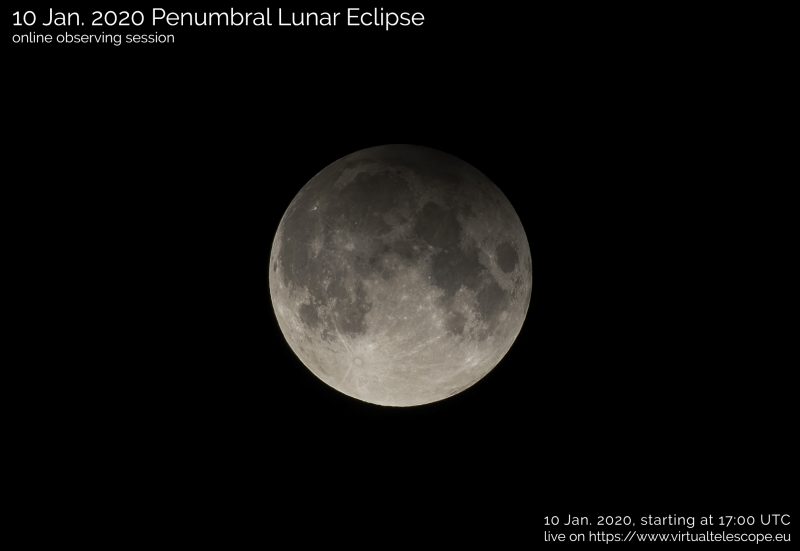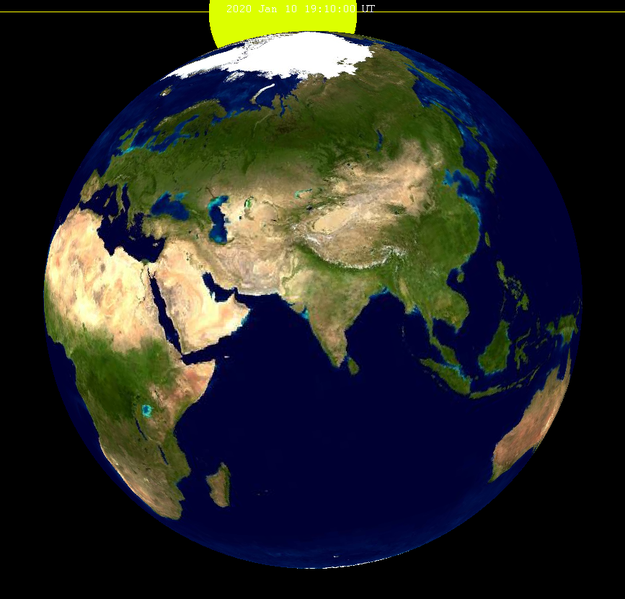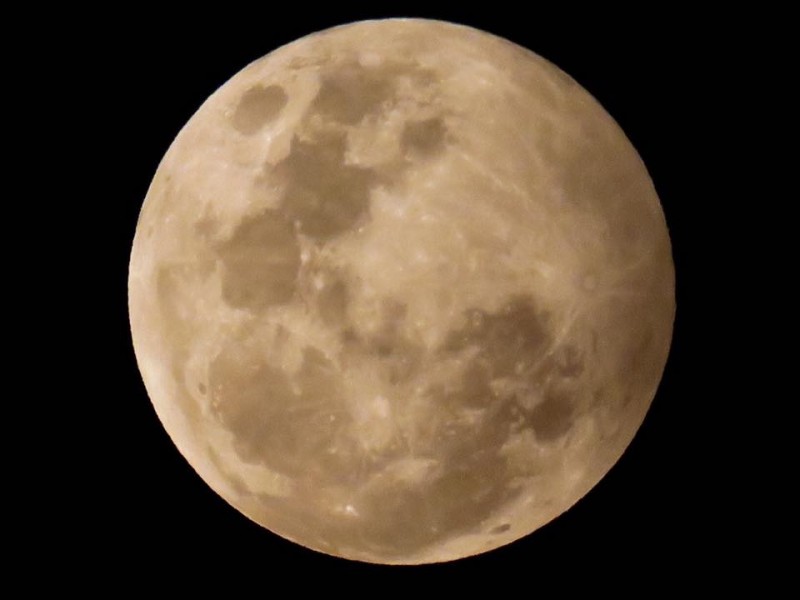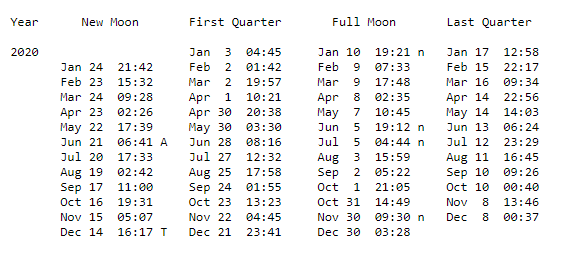
Image at top: Dave Chapman in Halifax, Nova Scotia, Canada, had high, thin clouds, but still managed to capture the penumbral eclipse of February 10, 2017, near its maximum. Penumbral eclipses are subtle. Can you spot the slight shading on the moon’s left?
These next few nights – January 9 and 10, 2020 – watch for the full-looking moon, our nocturnal sun, to light up the nighttime from dusk until dawn. And if you live in the world’s Eastern Hemisphere, you might – or might not – detect Earth’s faint penumbral shadow on the full moon’s face on the night of January 10-11 (Friday night or Saturday morning).
Your best chance of detecting the slight darkening on the full moon’s face will come at or near maximum eclipse (January 10, 2020, at 19:10 UTC; translate UTC to your time).
Or try TimeandDate for the eclipse time in your area.
Or watch online. See the poster – from the Virtual Telescope Project in Rome – below:
EarthSky 2020 lunar calendars are available! Nearly sold out. Order now!

The Virtual Telescope Project will cover the penumbral lunar eclipse online. The free session is scheduled for January 10, 2020, starting at 17:00 UTC. Translate UTC to your time. The eclipse will be shown above the skyline of Rome. Go to Virtual Telescope’s site for more info.
We in the Americas will enjoy seeing the full moon, but we’ll miss this eclipse. Although the full moon occurs at the same instant worldwide, the clock reads differently by time zone. Here, in the mainland United states, the moon turns full on January 10 at 2:21 p.m. Eastern, 1:11 p.m. Central, 12:11 p.m. Mountain and 11:11 a.m. Pacific. So, here in the United States, the full moon will come during our daylight hours, when the moon is still beneath our horizon.
And, by the way, in North America, we sometimes use the name Wolf Moon for the January full moon. Other full moon names for January include the Old Moon, or the Moon After Yule.

Day and night sides of Earth at the instant of full moon (January 10 at 19:21 UTC). The shadow line crossing the Atlantic Ocean depicts sunset January 10 while the shadow line at right (going through Australia) represents sunrise January 11. Image via Fourmilab’s EarthView.
This is the first of 2020’s six eclipses (two solar and four lunar).
Meanwhile, it’s the second eclipse of the present eclipse season, the first of which came with the solar eclipse on December 26, 2019.
So – speaking now in terms of a lunar year, not a calendar year – that’s 7 eclipses (3 solar, 4 lunar), the maximum number of eclipses possible in one 354-day lunar year of 12 lunar months (December 26, 2019, to December 14, 2020).
All four lunar eclipses in 2020 are hard-to-see penumbral eclipses. During all of these eclipses, the moon will miss Earth’s dark umbral shadow and travel instead through Earth’s outer faint penumbra.
The penumbral eclipse on the night of January 10-11, 2020, will feature the deepest eclipse of the bunch.

A year ago – on January 21, 2019 – Tom Wildoner captured this image of a total lunar eclipse from Weatherly, Pennsylvania. A lunar eclipse often recurs about 11 days earlier from one year to the next. But this year’s lunar eclipse on January 10, 2020 will be a hard-to-see penumbral eclipse.

On January 10, 2020, the full moon misses Earth’s dark umbral shadow but goes through Earth’s fainter outer penumbra, to present a barely perceptible eclipse. This eclipse would be more impressive from the moon, where you’d see a partial eclipse of the the sun. See the illustration below.
Around the time of every full moon, the moon appears full to the eye for several days in a row. But astronomers regard the moon as truly full at a well-defined instant, when the moon is 180 degrees opposite the sun in ecliptic longitude.
Or, another way of looking at it, the moon is precisely full whenever the elongation between the moon and sun equals 180 degrees. Visit Unitarium.com to know the present moon-sun elongation, remembering that a positive number means a waxing moon whereas a negative number indicates a waning moon.

Yes, the eclipse on January 10, 2020, would be more impressive from the moon, where you’d see it as a partial eclipse of the sun.
This month’s full moon – the first of 13 full moons in 2020 – falls on January 10 at 19:21 UTC; translate UTC to your time. Because we have 13 full moons this year, there will be a month with two full moons. That’ll be October 2020.
In modern skylore, the second full moon of a month commonly called a Blue Moon.

Penumbral eclipse over Sabah, North Borneo, from our friend Jenney Disimon on the night of March 23, 2016. Can you see the faint shading on the right side of the moon? During the January 2020 penumbral lunar eclipse, very observant people will look up and say, “Wow, the moon looks strange!” Others will look at the moon at mid-eclipse and claim they can’t notice any difference at all.
For the Northern Hemisphere, this January full moon presents the first of three full moons of the winter season; and in the Southern Hemisphere, this is the first of three summer full moons. For the world as a whole, this penumbral lunar eclipse features the second eclipse of the eclipse season, the first one staging an annular eclipse of the sun on December 26, 2019.
Because the full moon stands opposite the sun in Earth’s sky, the full moon assumes the sun’s position for six months hence, in July. From all over the world, this January full moon will shine in front of the constellation Gemini the Twins. Therefore, like the July sun, this January full moon will rise and set quite far north of due east and west.
In the Northern Hemisphere, that means this January full moon will follow the high path of the summer sun throughout the night.
Yet, in the Southern Hemisphere, where it’s summer, this January full moon will the low path of the winter sun.

The moon phases for the year 2020 via Astropixels. A = annular solar eclipse, T = total solar eclipse, and n = penumbral lunar eclipse. The year 2020 has 13 full moons, two of which take place in the month of October.
Bottom line: Wherever you may reside worldwide, enjoy the first full moon of the year on January 10, 2020, as it lights up the nighttime from dusk until dawn! This full moon will undergo a penumbral lunar eclipse. At mid-eclipse, you will find a slight shading – Earth’s penumbral shadow – on one side of the moon.
Read more: What is a penumbral eclipse?
Read more: What is an eclipse season?
from EarthSky https://ift.tt/37Q4tfW

Image at top: Dave Chapman in Halifax, Nova Scotia, Canada, had high, thin clouds, but still managed to capture the penumbral eclipse of February 10, 2017, near its maximum. Penumbral eclipses are subtle. Can you spot the slight shading on the moon’s left?
These next few nights – January 9 and 10, 2020 – watch for the full-looking moon, our nocturnal sun, to light up the nighttime from dusk until dawn. And if you live in the world’s Eastern Hemisphere, you might – or might not – detect Earth’s faint penumbral shadow on the full moon’s face on the night of January 10-11 (Friday night or Saturday morning).
Your best chance of detecting the slight darkening on the full moon’s face will come at or near maximum eclipse (January 10, 2020, at 19:10 UTC; translate UTC to your time).
Or try TimeandDate for the eclipse time in your area.
Or watch online. See the poster – from the Virtual Telescope Project in Rome – below:
EarthSky 2020 lunar calendars are available! Nearly sold out. Order now!

The Virtual Telescope Project will cover the penumbral lunar eclipse online. The free session is scheduled for January 10, 2020, starting at 17:00 UTC. Translate UTC to your time. The eclipse will be shown above the skyline of Rome. Go to Virtual Telescope’s site for more info.
We in the Americas will enjoy seeing the full moon, but we’ll miss this eclipse. Although the full moon occurs at the same instant worldwide, the clock reads differently by time zone. Here, in the mainland United states, the moon turns full on January 10 at 2:21 p.m. Eastern, 1:11 p.m. Central, 12:11 p.m. Mountain and 11:11 a.m. Pacific. So, here in the United States, the full moon will come during our daylight hours, when the moon is still beneath our horizon.
And, by the way, in North America, we sometimes use the name Wolf Moon for the January full moon. Other full moon names for January include the Old Moon, or the Moon After Yule.

Day and night sides of Earth at the instant of full moon (January 10 at 19:21 UTC). The shadow line crossing the Atlantic Ocean depicts sunset January 10 while the shadow line at right (going through Australia) represents sunrise January 11. Image via Fourmilab’s EarthView.
This is the first of 2020’s six eclipses (two solar and four lunar).
Meanwhile, it’s the second eclipse of the present eclipse season, the first of which came with the solar eclipse on December 26, 2019.
So – speaking now in terms of a lunar year, not a calendar year – that’s 7 eclipses (3 solar, 4 lunar), the maximum number of eclipses possible in one 354-day lunar year of 12 lunar months (December 26, 2019, to December 14, 2020).
All four lunar eclipses in 2020 are hard-to-see penumbral eclipses. During all of these eclipses, the moon will miss Earth’s dark umbral shadow and travel instead through Earth’s outer faint penumbra.
The penumbral eclipse on the night of January 10-11, 2020, will feature the deepest eclipse of the bunch.

A year ago – on January 21, 2019 – Tom Wildoner captured this image of a total lunar eclipse from Weatherly, Pennsylvania. A lunar eclipse often recurs about 11 days earlier from one year to the next. But this year’s lunar eclipse on January 10, 2020 will be a hard-to-see penumbral eclipse.

On January 10, 2020, the full moon misses Earth’s dark umbral shadow but goes through Earth’s fainter outer penumbra, to present a barely perceptible eclipse. This eclipse would be more impressive from the moon, where you’d see a partial eclipse of the the sun. See the illustration below.
Around the time of every full moon, the moon appears full to the eye for several days in a row. But astronomers regard the moon as truly full at a well-defined instant, when the moon is 180 degrees opposite the sun in ecliptic longitude.
Or, another way of looking at it, the moon is precisely full whenever the elongation between the moon and sun equals 180 degrees. Visit Unitarium.com to know the present moon-sun elongation, remembering that a positive number means a waxing moon whereas a negative number indicates a waning moon.

Yes, the eclipse on January 10, 2020, would be more impressive from the moon, where you’d see it as a partial eclipse of the sun.
This month’s full moon – the first of 13 full moons in 2020 – falls on January 10 at 19:21 UTC; translate UTC to your time. Because we have 13 full moons this year, there will be a month with two full moons. That’ll be October 2020.
In modern skylore, the second full moon of a month commonly called a Blue Moon.

Penumbral eclipse over Sabah, North Borneo, from our friend Jenney Disimon on the night of March 23, 2016. Can you see the faint shading on the right side of the moon? During the January 2020 penumbral lunar eclipse, very observant people will look up and say, “Wow, the moon looks strange!” Others will look at the moon at mid-eclipse and claim they can’t notice any difference at all.
For the Northern Hemisphere, this January full moon presents the first of three full moons of the winter season; and in the Southern Hemisphere, this is the first of three summer full moons. For the world as a whole, this penumbral lunar eclipse features the second eclipse of the eclipse season, the first one staging an annular eclipse of the sun on December 26, 2019.
Because the full moon stands opposite the sun in Earth’s sky, the full moon assumes the sun’s position for six months hence, in July. From all over the world, this January full moon will shine in front of the constellation Gemini the Twins. Therefore, like the July sun, this January full moon will rise and set quite far north of due east and west.
In the Northern Hemisphere, that means this January full moon will follow the high path of the summer sun throughout the night.
Yet, in the Southern Hemisphere, where it’s summer, this January full moon will the low path of the winter sun.

The moon phases for the year 2020 via Astropixels. A = annular solar eclipse, T = total solar eclipse, and n = penumbral lunar eclipse. The year 2020 has 13 full moons, two of which take place in the month of October.
Bottom line: Wherever you may reside worldwide, enjoy the first full moon of the year on January 10, 2020, as it lights up the nighttime from dusk until dawn! This full moon will undergo a penumbral lunar eclipse. At mid-eclipse, you will find a slight shading – Earth’s penumbral shadow – on one side of the moon.
Read more: What is a penumbral eclipse?
Read more: What is an eclipse season?
from EarthSky https://ift.tt/37Q4tfW

Aucun commentaire:
Enregistrer un commentaire